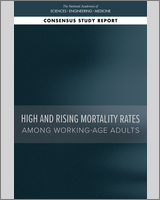From: 4, U.S. Trends in Cause-Specific Mortality Among Working-Age Adults

High and Rising Mortality Rates Among Working-Age Adults.
National Academies of Sciences, Engineering, and Medicine; Division of Behavioral and Social Sciences and Education; Committee on National Statistics; Committee on Population; Committee on Rising Midlife Mortality Rates and Socioeconomic Disparities; Becker T, Majmundar MK, Harris KM, editors.
Washington (DC): National Academies Press (US); 2021 Mar 2.
Copyright 2021 by the National Academy of Sciences. All rights reserved.
NCBI Bookshelf. A service of the National Library of Medicine, National Institutes of Health.